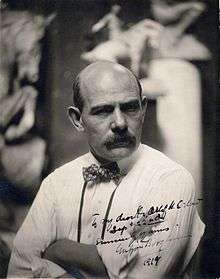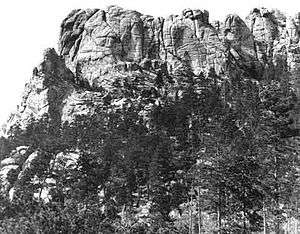Construction of Mount Rushmore
Coordinates: 43°52′58.41″N 103°27′20.13″W / 43.8828917°N 103.4555917°W

The construction of Mount Rushmore National Memorial took 14 years, from 1927 to 1941.
Designing the monument
Doane Robinson of the South Dakota Historical Society wanted a monument to be built in South Dakota in order to help the economy of the state by attracting tourism. In 1923, he proposed that this monument should be built from the granite cliffs in the Black Hills of South Dakota. Senator Peter Norbeck of South Dakota approved the proposal, and federal funding helped the project. Robinson asked architect and sculptor Gutzon Borglum to sculpt and design the monument. Borglum decided to use Mount Rushmore for the sculpture, since it seemed to be the easiest and most stable of the cliffs to work on.[1]
Having decided on the location of the sculpture, Borglum decided to make the monument of four presidents of the United States. He chose the two most famous presidents in American history, George Washington and Abraham Lincoln. He chose Thomas Jefferson because Jefferson nearly doubled the size of the United States in the 1803 Louisiana Purchase (which included the land that became South Dakota). The last president Borglum chose was Theodore Roosevelt, suggested by President Calvin Coolidge (who insisted that at least there be two Republicans and at least one Democrat represented)[2] because of Theodore Roosevelt's introduction of the National Park Service.
Borglum's original design was a sculpture of each president intended to go down to their waists, but time constraints and funding only provided for their heads.[3] Ivan Houser, father of John Sherrill Houser, was assistant sculptor to Gutzon Borglum during the early years of carving; he began working with Borglum shortly after the inception of the monument and was with Borglum for a total of seven years. When Houser left Gutzon to devote his talents to his own work, Borglum's son, Lincoln, became assistant sculptor.
Construction


A few hundred workers, most of whom were miners, sculptors, or rock climbers, used dynamite, jackhammers, and chisels to remove material from the mountain. A stairway was constructed to the top of the mountain, where ropes were fixed. Workers were supported by harnesses attached to the ropes.
The irises of the eyes were sculpted as holes. A cube of granite was left in each to represent the reflection highlight thereby making the appearance of the eyes more realistic.
Construction began on October 4, 1927. In 1935 Borglum appointed Italian immigrant Luigi Del Bianco as chief carver.[4]
George Washington

George Washington's head was started first. Due to the economic instability of the United States caused by the Great Depression, it was completed in seven years, and dedicated to the public on Independence Day 1934. A large American flag was placed over Washington's head before it was revealed, and this became a tradition for each of the presidents' heads.
Thomas Jefferson
Thomas Jefferson's head was started next, to the right of Washington. Before the head was complete, Borglum requested that it should be blasted off due to poor rock quality. Jefferson's head was restarted on Washington's left. Jefferson's head was dedicated in 1936.
Abraham Lincoln
Abraham Lincoln's head was the most challenging because of his beard, but his head was completed on the far right of the cliff. Dedicated on September 17, 1937, it took 2 days, which was the 150th anniversary of the signing of the Constitution of the United States in 1787.
Theodore Roosevelt
While Roosevelt's head was being constructed, accommodations for tourists were being built, including plumbing, lighting, and a visitor center. Not finding suitable rock, the sculptors cut farther back into the mountain, causing concerns about how far they were cutting. Roosevelt's head was dedicated on July 2, 1939.
Hall of Records
Due to unforeseen vulnerabilities in the granite, Lincoln and Jefferson were moved from the locations in Borglum's original design. Lincoln was shifted to the spot that Borglum had planned to include an 80-by-100-foot inscription in the shape of the Louisiana Purchase.
To replace the inscription, Borglum conceived another grand addition to the monument of similar proportions: the Hall of Records. The Hall of Records was to include a grand entrance to an 80-by-100-foot vault carved directly into the granite face of the small canyon behind Lincoln’s head. Borglum imagined 800 granite steps leading from his studio to the entrance of the Hall.
In 1938, Borglum and his crew began to carve this grand hall, where he envisaged the original Declaration of Independence and United States Constitution should eventually be stored. But a combination of unexpectedly hard granite, looming war in Europe, and lack of funding conspired against Borglum’s last dream, though his plans became more elaborate as his team rushed to complete this work. They had reached 70 feet into the granite by March 1941, when Borglum unexpectedly died. The monument was deemed complete and all work shut down on October 31 of the same year. Though Borglum’s children tried over the years to renew interest in their father’s last dream, it was not until 1998 that the National Park System, together with the Borglum Family, put “finishing touches” on the Hall of Records. A titanium vault was installed in the granite floor of the unfinished hall, and filled with 16 porcelain enamel panels that include the United States Constitution and other important historical documents. The Hall of Records entrance can be seen from west-facing aerial photographs of the monument.[5][6]
Present day

The Presidential Trail, a walking trail and boardwalk, starts at Grandview Terrace and travels through the forests to the sculptor's studio, now a museum with information about the construction of the monument and the tools used by workers.[7]
References
- ↑ People & Events: Doane Robinson (1856-1946)
- ↑ Fite, Gilbert C. Mount Rushmore (May 2003). ISBN 0-9646798-5-X.
- ↑ Rushmore
- ↑ "Italian immigrant finally gets his due as Rushmore's chief carver". New York Times. July 11, 2016. Retrieved July 11, 2016 – via Minneapolis Star Tribune.
- ↑ Park - see Hall of Records
- ↑ Mount Rushmore Natl. Memorial, SD - Bing Maps
- ↑ Rushmore's Story | Junk Worth Knowing.